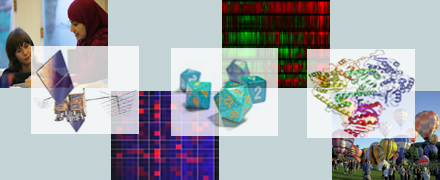SuSTaIn
About
News
Postgraduate degrees
Activities
Jobs
Management
Contact us
Statistics Group
Statistics Home
Research
Members
Seminars
Statistics@Bristol
Mathematics Home
External Links
APTS
Complexity science
Royal Statistical Society
International Society for Bayesian Analysis
|
|
Graphical models and complex stochastic systems
Lecturer: Peter Green, Statistics group
Test
Here it is!
| Winbugs code for bonus question
| Solutions and comments
Syllabus
- Introduction and motivation: complex stochastic systems in science and technology
- Basic ideas of statistical inference. Probability, statistics and data analysis. Models and data. Estimation, confidence intervals and hypothesis testing.
Maximum likelihood. Bayesian analysis.
- Conditional independence: axioms, graphical representations, directed acyclic graphs.
- Exchangeability and hierarchical models: Bayesian formulations.
- Bayes nets and expert systems; exact computation by probability propagation.
- Hidden Markov models and state-space models.
- Undirected and chain graph models. Markov random fields and Gibbs distributions. Hammersley-Clifford theorem, spatial models.
- Equilibrium simulation: Markov chain Monte Carlo.
- Model selection and criticism.
- (Learning structure.)
- (Graphical models and causal reasoning.)
- (Role of graphical modelling in computation: specification, visualisation, algorithms.)
Complexity Science graduate programme:
course materials page for this module
Related unit: M6002 Graphical modelling (weeks 13-18, in Mathematics)
Lectures:
1 (pdf/ppt)
| 2
| 3-4
| 5
(& extra figs)
| 6 (pdf/ppt)
| 7
| 8 (pdf/ppt)
| 9
| 10
Demo code
Brief instructions
Lecture 2:
binomial likelihood |
normal likelihood |
comparing estimators
Lecture 3:
likelihood for mixture of two normals
| beta-binomial
Lecture 6:
'Asia' expert system
| biased coins
| hierarchical binomial model
| paternity query
| mixed trace forensic problem
Lecture 7:
2 state Markov chain
| simple hidden Markov model
Lecture 9:
3 Winbugs demos
Exercises 1:
random walk |
percolation
Software
R |
gR |
Grappa |
Hugin (expensive) |
Hugin 5.7 (free) |
WinBugs
Tutorial on R
To run R (version 2.6.0), Hugin (version 5.7) or WinBugs (version 1.4.3) on the BCCS PC's, look under
Start | All Programs | Engineering Apps
Exercises
Sheet: 1
| 2
| 3
| 4
| 5
Some relevant work of mine
- Barndorff-Nielsen, Cox and Klüppelberg (eds.) Complex Stochastic Systems, Chapman and Hall, London, 2001.
- Cappé, Moulines and Rydén. Inference in Hidden Markov Models. Springer, 2005.
- Cowell, Dawid, Lauritzen and Spiegelhalter. Probabilistic Networks and Expert Systems. Springer-Verlag, 1999.
- Gelman, Carlin, Stern and Rubin. Bayesian Data Analysis, Chapman & Hall/CRC, 2003.
- Green, Hjort and Richardson. Highly Structured Stochastic Systems, OUP, 2003.
- Gilks, Richardson and Spiegelhalter. Markov Chain Monte Carlo in Practice, Chapman & Hall, 1996.
- Lauritzen. Graphical Models, OUP, 1996.
- Pearl. Causality: Models, Reasoning and Inference, CUP, 2000.
- Titterington (ed.) Complex Stochastic Systems and Engineering, IMA Conference Series No. 54. OUP, 1995.
- Whittaker. Graphical Models in Applied Multivariate Statistics, Wiley, 1990.
|


